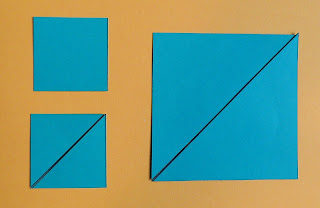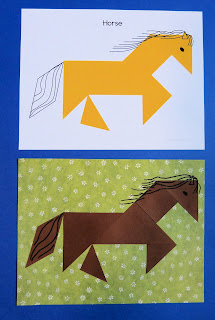When I first introduce anything to my students, I like to allow them plenty of time to explore and discover on their own. This is something I was urged to do way back in teacher training, and 25 years teaching has reinforced. It's amazing what students will come up with when you let them explore and play!
Next I display a big tangram shape. I ask students to tell me what they notice. This is when I usually hear the names of the shapes, some words about size, and there's almost always someone who refers to the "diamond" shape, which is just the square turned onto a corner. Being a tiny bit silly (who me?) I ask the children what my name is - Ms. Paula. I then strike various silly poses and ask again - and each time my name is still the same. It's the same with the square - turn it any which way you like, it's still a square!
Another great word and concept that comes up at this time is parallel. For most of the children I've taught, that's a new word. We look around the room for things that are parallel: the sides of our desks, the lines in the ceiling tiles, bookshelves, and more. Although this is a brief mini lesson, only lasting a minute or so, I carry it over into the rest of the week by noticing or asking children to notice parallel lines around the school. Pretty soon they have that concept firmly in place.
The next thing I like to do is to hide my tangram, and provide each child with their own tangram and ask then to make me a square. I bet you can picture which child in your class will be a smarty and hold up the small square!
I challenge them to make a square, and it doesn't take long for someone to use 2 equal sized triangles to do it. The tangram set includes 2 small triangles and 2 big triangles, so there's more than 1 way to do it - I love telling my students to keep trying and look for another way, it's just the sort of challenge they're eager to figure out!
It's very rare to have a student use all 7 pieces to make a square, in fact, most adults I've met can't figure it out. I give the children a few minutes to try, and when I sense they're ready, I begin to give them clues. I show them how to use the 2 big triangles to make half of the square - it's helpful to define the space where the rest of the pieces will go.
A few minutes later I add the square,
then the medium triangle.
Eventually all the children get it.
That's my introduction to tangrams - next comes the part I like the best! I show students pictures that can be made with tangrams, and challenge them to try to make them. You can find hundreds of tangram puzzle shapes with a quick internet search, or for simplicity, I have a variety of these puzzles available in my TeachersPayTeachers store.
It's ideal to have both the puzzle and the answer key available, because many students will be challenged to simply rotate and match the shapes, while others will relish the challenge of figuring it all out. I put them back to back in a page protector, so students can easily flip and check.
Don't have tangrams in your classroom yet, and don't have a budget for them? No problem! Download this free print
I hope you and your students enjoy exploring tangrams together!










